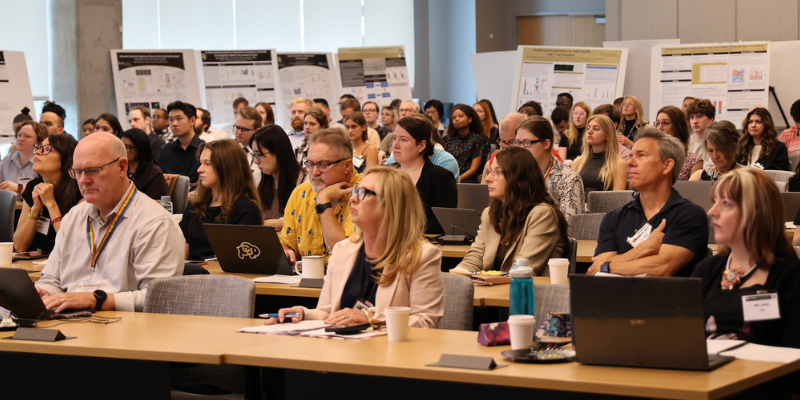According to Kristofer Fritz, PhD, associate professor in the School of Pharmacy’s Pharmaceutical Sciences Department, bench-side research requires a lot of trial and error. Also, according to Dr. Fritz, it takes a certain kind of fortitude and dedication for a PharmD student to undertake an intensive lab-based research project due to the already-demanding academic rigors of a pharmacy degree.
P4 Stefanie Schwab,
recipient of a Student Research
Award for her research related
to diabetic kidney disease
However, fourth-year doctor of pharmacy student, Stefanie Schwab, is not one to shy away from a challenge; especially when it comes to research.
Schwab started her graduate education in the PhD program at Purdue, but soon recognized that she missed the clinical aspect of interacting with patients. The CU Pharmacy degree offered what she refers to as a “hybrid opportunity,” allowing her to pursue both research and clinical interests.
It Never Hurts to Ask
“During honors welcome week, they said it was our responsibility, that if you want to do research, you have to find your own faculty advisor,” recalls Schwab. “So, the first semester I was looking at different people. Dr. Fritz taught in our biochemistry course, and what he talked about was something I’ve always found fascinating.”
Dr. Fritz remembers Schwab’s initial request to work in his research lab.
“(Because of the demanding nature) an analytical research project is not something that I would have set up to be a good project for a PharmD honors student,” reflects Fritz. “But then you meet Stefanie and you say, ‘OK you have the background – you did two years in grad school. Let’s do this’.”
Thanks to Fritz’s openness, Schwab soon found herself working as a “wet lab” student researcher studying kidney tissue from “diabetic mice”. Schwab’s big break came when Dr. Fritz used his connections with colleagues at Johns Hopkins to secure human kidney tissue for her research endeavor.
A sample of the diabetic
kidney tissue that Schwab
used in her research
The tissue samples that arrived included normal, non-diseased kidney tissue, as well as diabetic kidney tissue. It would be Schwab’s job to examine the two different samples at the molecular level, with the goal of determining what protein changes exist between the healthy and the diabetic kidney tissue.
Like Ornaments on a Christmas Tree
Dr. Fritz uses a Christmas tree analogy to describe the research known as proteomics. Visualize a protein molecule like a Christmas tree with ornaments. Researchers have studied the “Christmas tree,” but never the “ornaments” in these preserved tissues – those molecular modifications that occur as a result of disease, in this case, diabetes.
No one, that is, until Schwab.
Dr. Fritz finds it hard to contain his enthusiasm as he explains Schwab’s extraordinary accomplishment.
“No one in the world has ever been able to extract that protein and look at the changing “ornaments” on them,” he says. “Stefanie extracted them, and is looking at what we call acetylation . . . by her being able to develop this research method, we can now look at how those signals (ornaments) are changing in response to diabetic hyperglycemia or diabetic kidney disease. So, if a protein is inhibited, if you’re shutting down the enzyme activity of it, is there a drug that will activate it? And then will that help the kidney recover or prevent the damage occurring in diabetic kidney disease or other consequences of kidney disease?”
Schwab's research advisor,
Dr. Kristofer Fritz
The potential patient-centered impact of Schwab’s research could have far-reaching implications. But, just how did a doctor of pharmacy student achieve such a breakthrough research result?
Bridging the Knowledge Gap
“There wasn’t a clear path getting from point A to point B,” says Schwab, “It took a lot of extra research to bridge the knowledge gap and basically glue together different processes; what’s been done before and what would make the most sense for what we were trying to study.”
Translation: Trial, error, and, according to Dr. Fritz, hardcore chemistry.
The original tissue samples arrived, chemically fixed and embedded in blocks of paraffin wax. Schwab used the readily available mice tissue to experiment with different extraction methods. She would ultimately move to the human samples where she would slice a thin piece of tissue out of the wax, and experiment with heat to partially release the tissue from the paraffin, followed by other organics that complete the process; all the while making sure that the samples did not get too cold which would harden the wax and return the process to square one. And that was all before she even started the process of removing spider-web like crosslinks among the proteins.
A detail of Schwab's award-
winning research poster
Schwab’s 36-month research project recently caught the attention of the 2021 CU Anschutz Student Research Symposium in which she beat out more than 100 students to win a coveted Student Research Award and a $300 cash prize.
Finding the Balance
“My longtime goal would be to do clinical work and clinical research. I’m very interested in psychiatry, mostly because there’s lots of room for discovery, specifically with the pathogenesis of certain conditions like schizophrenia,” says Schwab. “There is a lot known, but there’s a lot left to be understood so there could be better therapeutics developed to target those disease states.”
When she’s not engaged with ground-breaking research, she feeds her passion for patient-centered work by volunteering at a number of high-need facilities. Schwab helped start the Dawn Transgender Clinic, a student-run free health center in Aurora. One Saturday a month she travels to Colorado Springs to work at the Medical Mission Clinic which serves those who are uninsured and have fallen through the traditional healthcare system.
As of this writing, Schwab has successfully defended her honors project and been matched for a fellowship at Riverside University Health System in southern California.
“Being able to pursue both research and clinical interests is important to me.” Says Schwab, “That’s the balance that I'm looking for.”
.png)







